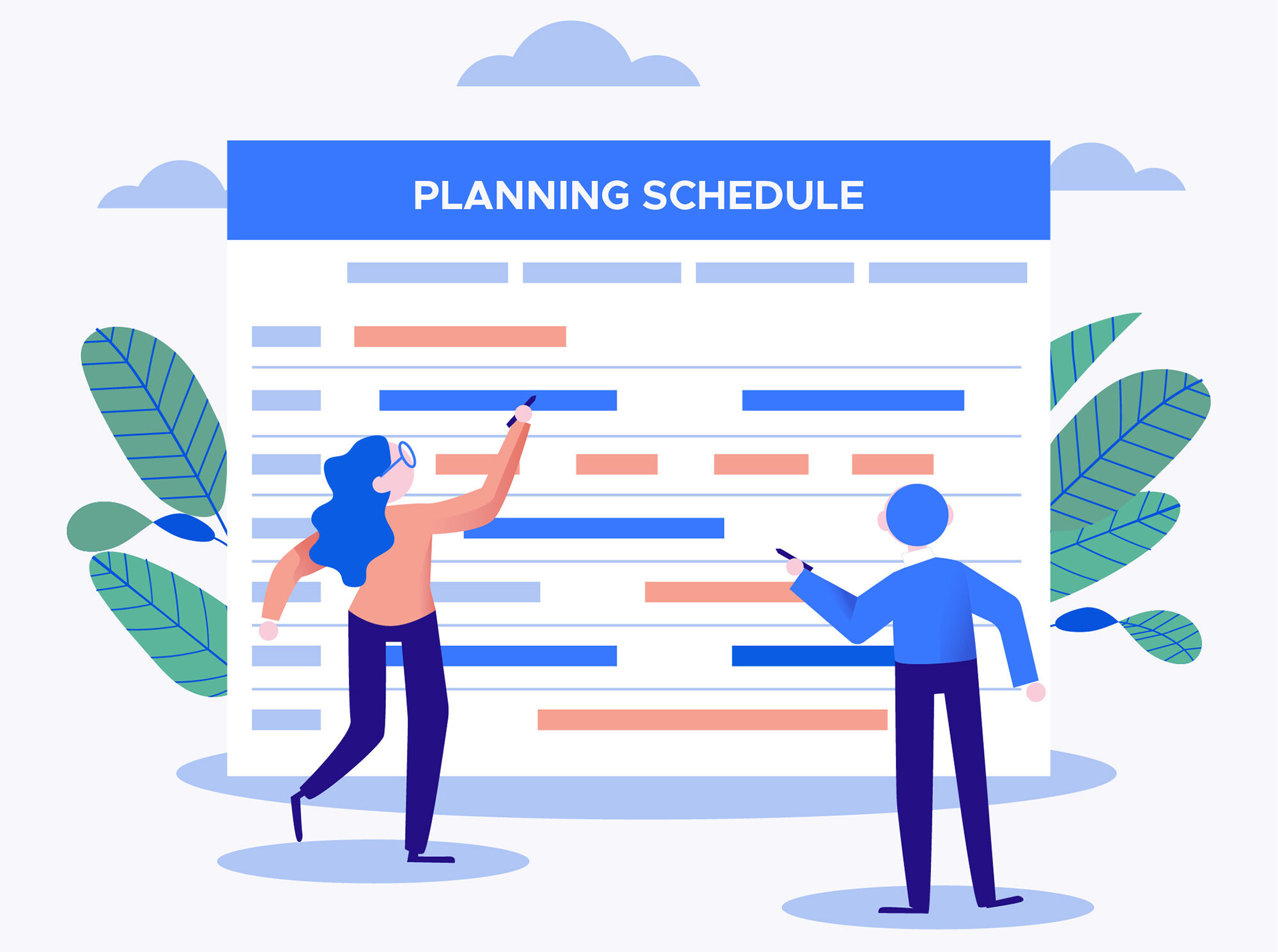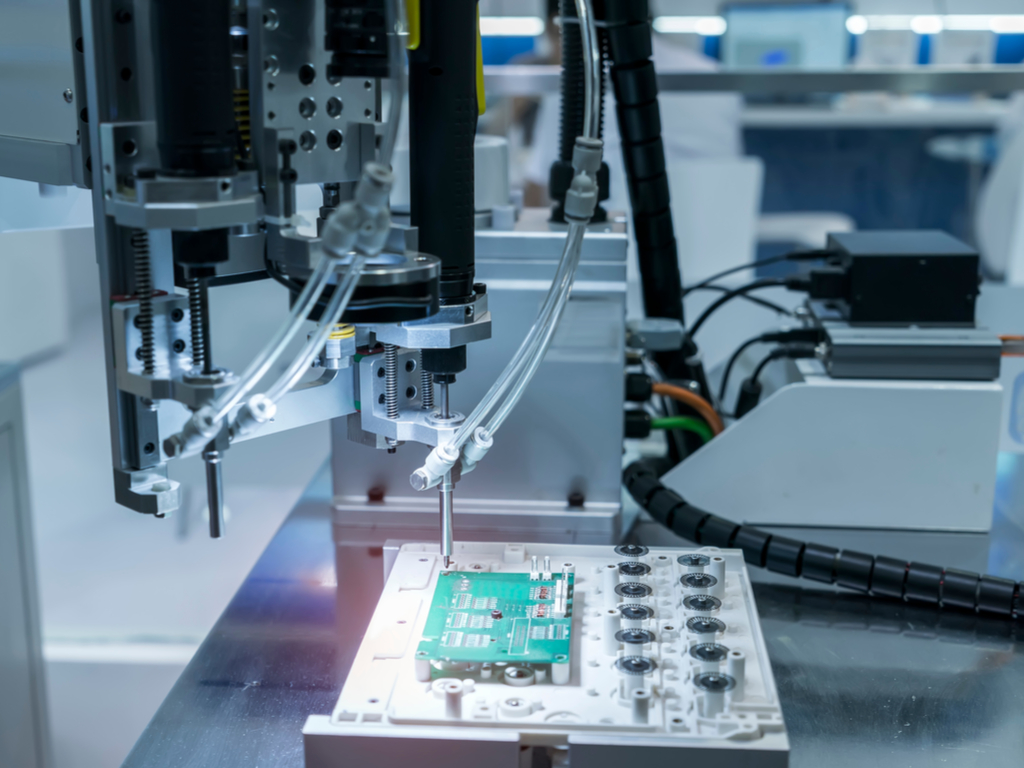
To begin with, meticulous project planning is the foundation for on-time PCB delivery. It involves creating a detailed timeline and milestones, considering the PCB manufacturing and delivery schedules. By incorporating the manufacturing timeline into the overall project plan, you can ensure timely delivery throughout the project. The importance of creating a detailed schedule lies in providing a clear framework for each team member to know when to accomplish their respective tasks. The schedule should include the time allocation for PCB manufacturing and delivery, ensuring on-time delivery throughout the project timeline. By incorporating the time requirements for PCB manufacturing into the schedule, it ensures that other tasks and phases remain synchronized with PCB production, avoiding resource bottlenecks and delays. Assuming your PCB project needs to be completed within 10 weeks. In the schedule, you can specify PCB manufacturing to begin in week 2 and delivery to be made in week 6. This way, your team can schedule other tasks such as design, testing, and integration based on this timeline. Without a clear schedule in place, it could lead to confusion among team members regarding task priorities and deadlines, thus increasing the risk of delays. Additionally, listing the time schedule for PCB manufacturing and delivery is also crucial. This includes the lead time of PCB manufacturers, the time required for bulk production, as well as transportation and delivery to your location. By clearly outlining these time schedules, you can better assess the time requirements of the entire project and have clear communication with your team and suppliers. For example, let's say you have chosen a reliable PCB manufacturer who requires 2 weeks to manufacture the PCBs after receiving the files, and they will deliver them to you within 1 week after manufacturing is complete. Additionally, considering transportation and delivery time, an approximate additional week is needed. Therefore, from placing the order to final delivery, a total of 4 weeks is required. Incorporating these timeframes into your schedule can help ensure that other tasks within your team align with the PCB manufacturing and delivery schedule, allowing the entire project to be completed on time. By establishing a detailed schedule and milestones in project planning, you can lay a solid foundation for successful project delivery. Doing so enhances the team's awareness of time requirements and ensures timely progress across all aspects of the project, thereby avoiding delays and unnecessary conflicts.
Next, selecting a reliable supplier is paramount for successful PCB delivery. Choosing an experienced, reputable, and reliable PCB manufacturer is crucial. Their expertise and reliability directly impact the quality and timely delivery of the PCBs. Let's delve into the importance of choosing such a supplier and explore some methods to evaluate their reputation and track record. A supplier with experience and a good reputation is more likely to provide excellent products and services. They have often been operating in the industry for many years, accumulating valuable experience and establishing a reliable reputation. The reputation and track record of a supplier can be assessed through the following methods. Refer to customer reviews and feedback. Look for customer reviews and feedback about the supplier, especially from clients in similar industries. Their experiences and opinions can provide crucial insights into the quality and reliability of the supplier. Checking supplier qualifications and certifications. Find out if the supplier has obtained industry-recognized certifications such as ISO 9001 Quality Management System certification. These certifications indicate that the supplier adheres to stringent quality standards and possesses capabilities in terms of reliability and dependability. Research supplier's track record. Investigate the supplier's history to understand their track record in project delivery and customer satisfaction. Communicate with the supplier and inquire about their past project experiences and success stories.

For example, let's assume your project requires manufacturing complex high-frequency PCB boards with stringent dimensional accuracy and reliable performance. In such a scenario, choosing an experienced and reputable supplier is crucial. For example, SprintPCB is a renowned supplier with 15 years of experience in the PCB manufacturing field. They possess specialized expertise in high-frequency circuit design and manufacturing and have achieved remarkable results in similar projects. Customer feedback indicates that the PCB boards they deliver are of stable quality, meet the requirements, and are consistently delivered on time. Such a supplier has the capability to handle complex projects and can meet your specific needs. When selecting suppliers, you can use the following methods to assess their reputation and track record. Conduct supplier surveys. Interact with other clients or industry experts to gather their evaluations and experiences with the suppliers. Seek information about the supplier's reputation and standing, which will provide valuable reference opinions. Visit the supplier's factory. If possible, arrange a visit to the supplier's production facility. This will allow you to witness their manufacturing processes and quality control measures firsthand, further evaluating their reliability and capabilities. Conduct supplier interviews. Prior to selecting a supplier, engage in face-to-face or remote meetings with them to learn about their team, processes, and project management capabilities. This will help you gain a better understanding of whether they align with your needs and expectations. By choosing an experienced, reputable, and reliable supplier, you can maximize the success rate of your PCB project delivery. Ensure careful evaluation of their reputation and track record when selecting a supplier to ensure smooth collaboration with them.

Moreover, booking manufacturing time in advance is essential to avoid delays. PCB manufacturing typically requires a specific lead time, especially during peak production seasons. By reserving manufacturing time early on, you can secure a suitable production window and prevent potential delays. PCB manufacturing typically requires a certain amount of time, especially during busy production seasons. If you wait until the final stages of the project to book manufacturing time, you may find that there are no suitable production windows available for scheduling, resulting in project delays. Therefore, booking manufacturing time in advance is a wise decision. By booking manufacturing time in advance, you can ensure that sufficient time is allocated for the PCB manufacturer to process your order. This allows them to properly schedule production resources, procure materials, and arrange staff to meet your time requirements. In addition, booking manufacturing lead time in advance can also provide you with some buffer space. If unexpected issues or changes in requirements arise during the manufacturing process, you will have enough time to adjust and address them without impacting the overall project timeline. To successfully book manufacturing time, it is crucial to establish a good working relationship with your chosen PCB manufacturer. Initiate early communication and clearly express your time requirements, sharing detailed project information with the manufacturer so that they can accurately assess the required manufacturing time. Additionally, ensure to follow up and confirm the booking after the scheduled time to ensure that your order has been accepted and scheduled into the production plan. In conclusion, pre-booking manufacturing time is crucial for ensuring the on-time delivery of PCB projects. It provides manufacturers with sufficient time to process your orders and allows you the flexibility to address potential issues and changes. Through close collaboration and timely communication with the manufacturer, you can effectively manage manufacturing lead time and ensure the project is delivered on schedule.

Continual monitoring of the manufacturing process is vital to ensure on-time delivery. Close collaboration with the PCB manufacturer is necessary to regularly track progress and promptly address any delays or issues that may arise. Effective communication and timely adjustments are key to maintaining project schedules. Having face-to-face meetings with the manufacturer to communicate project requirements and timelines, ensuring mutual understanding and shared goals. Establishing a long-term partnership with the manufacturer, allowing them to gain a better understanding of your needs and increasing the likelihood of prioritizing your project. Providing the manufacturer with detailed design and specification documents required, enabling them to better understand your requirements and carry out accurate manufacturing. Regular progress update meetings with the manufacturer to understand the manufacturing progress and ensure it aligns with the project schedule. Tracking the manufacturing status of the PCB, including confirming the arrival time of raw materials, sample production, and progress of batch manufacturing. Conducting regular visits to the manufacturing site to personally observe the manufacturing process and address any potential issues or bottlenecks. Requesting regular updates on the manufacturing progress from the manufacturer, so that you can stay informed about the project's progress. Establishing effective communication channels, such as email, phone, or online collaboration platforms, to facilitate timely communication of any issues or changes. Sharing the project schedule and delivery requirements with the manufacturer and ensuring they understand and can meet those requirements. Establish a risk management plan, including an early warning system, to identify potential manufacturing delays or issues early on and take appropriate corrective actions.

Furthermore, optimizing the design for manufacturing efficiency plays a critical role. Collaborating with the PCB manufacturer to understand their manufacturing requirements and best practices is crucial. Making design adjustments based on this knowledge can reduce potential manufacturing issues and errors, preventing delays. Avoid complex routing. Complex routing and excessive layering increase the complexity of manufacturing and assembly. By simplifying the routing and reducing the layers, errors and issues during the manufacturing process can be reduced. For example, managing signals and power lines using appropriate rules and constraints can help minimize signal interference and power noise. Ensure component availability. When designing a PCB, it is important to ensure the availability and delivery time of the selected components. Collaborate with manufacturers to understand their recommended common and reliable components and avoid using outdated or hard-to-source components. This helps to prevent potential delays down the line due to the need for design changes or waiting for component supply. Optimize size and layout. Rational optimization of PCB size and layout can reduce manufacturing costs and time. Oversized PCBs may require longer manufacturing time and incur higher costs. Collaborate with manufacturers to understand their maximum board size and recommended size specifications, enabling appropriate adjustments during the design phase. Following best practices is crucial. Collaborating with manufacturers and understanding their best practices is key to ensuring manufacturability. Different manufacturers may have different requirements and technical specifications. For example, some manufacturers may excel in handling specific types of designs or specific materials. By communicating with manufacturers and understanding their requirements and recommendations, appropriate adjustments can be made during the design phase to improve manufacturing efficiency. Using simulation and validation tools. Utilizing advanced PCB simulation and validation tools can help predict and address potential manufacturing issues during the design phase. For instance, by conducting signal integrity simulations, signal interference and timing issues can be detected, thereby avoiding manufacturing errors and delays in later stages. By considering manufacturing feasibility and implementing corresponding design optimization measures, errors and issues during the manufacturing process can be reduced, thus improving manufacturing efficiency and ensuring the on-time delivery of PCB projects. Methods for collaborating with manufacturers and understanding best practices include: Regular meetings and discussions with manufacturers to understand their requirements and recommendations. Seeking feedback and opinions from manufacturers to make appropriate adjustments during the design phase. Participating in training and seminars organized by manufacturers to stay updated on the latest manufacturing technologies and best practices. Building close collaborative relationships and working with manufacturers to address potential manufacturing issues. By working closely with manufacturers and leveraging their expertise and experience, it is possible to optimize the design for improved manufacturing efficiency and ensure the on-time delivery of PCB projects.

Before proceeding with mass production, conducting appropriate sample testing and validation is essential. This helps identify and resolve any potential issues, ensuring that the final product meets the required specifications and minimizing delays and quality issues during the production phase. Thorough testing and validation are necessary to address any potential issues before mass production. Primarily, sample testing is crucial for quality assurance. By conducting comprehensive testing and validation on samples, potential design flaws, material issues, or manufacturing process defects can be identified. For instance, circuit connectivity issues, poor soldering, or wiring errors may be discovered. By promptly detecting and addressing these issues, it is possible to prevent large-scale quality problems during mass production, thereby reducing the need for rework and re-manufacturing. Actual examples can better illustrate the importance of sample testing. Let's consider a project that involves manufacturing complex high-speed circuit boards with numerous intricate signal paths. If design wiring errors or circuit connectivity issues are not identified during the sample testing phase, it can result in a significant number of functional failures during large-scale production. This would lead to delays and additional costs in the production phase as a substantial number of circuit boards would need to be reworked or repaired. However, by conducting appropriate sample testing, these issues can be identified and resolved early on, ensuring a smooth production phase, and avoiding delays and quality issues. Additionally, sample testing can help identify delays and quality issues in the production stage. By conducting thorough testing and validation during the sample testing phase, potential issues that could cause manufacturing delays can be discovered. For example, if it is found during sample testing that a material supplier cannot provide the required materials in a timely manner, early negotiations and measures can be taken to avoid supply delays in the production stage. Similarly, sample testing also aids in identifying quality issues during the manufacturing process, such as inadequate material quality or unstable manufacturing processes. By addressing these issues during the sample testing phase, delays in the production stage can be reduced, and the product's quality can be ensured to meet the requirements. Therefore, conducting appropriate sample testing is crucial for ensuring the quality and timely delivery of PCB projects. It can help identify and address potential design and manufacturing issues, improve product quality, and avoid delays and quality issues in the production phase. By conducting thorough and comprehensive testing during the sample testing stage, it ensures the project is delivered on time and provides high-quality PCB products.

Lastly, maintaining effective communication with all stakeholders is key to on-time PCB delivery. Regularly updating progress, sharing timelines and project requirements, and promptly communicating any changes or risks are vital. Transparent and efficient communication ensures that all parties understand and adhere to the project's time requirements, leading to successful delivery. Regularly update progress. Providing project progress reports to relevant stakeholders on a regular basis is an effective communication method. For example, holding meetings weekly or biweekly to report work progress to project managers, team members, and other relevant stakeholders. These updates can include the progress of PCB manufacturing, identification of any potential issues or risks, and the corrective measures taken. Through this approach, all stakeholders can stay informed about the latest status of the project, take timely actions, and provide feedback. Timely communication of changes or risks is crucial. If any changes or risks arise during the project, it is essential to communicate them promptly with the relevant stakeholders. For example, if there is a need to modify the PCB design or if the supplier encounters supply issues, it is important to immediately convey this information to the project manager and relevant stakeholders. Such timely communication can help minimize delays, coordinate actions among parties involved, and find solutions to prevent negative impacts on the project timeline. Establish clear communication channels. Ensure the establishment of clear communication channels, including regular meetings, email, instant messaging, etc., to keep in touch with the stakeholders. Determine who should be involved and receive updates on project progress, as well as how to communicate changes and risks. Using project management tools. Utilizing project management tools can help organize and share project information, ensuring convenient access for stakeholders. These tools provide features such as progress tracking, issue tracking, and document sharing, facilitating information exchange and collaboration. Encourage open and transparent communication. Encourage team members and stakeholders to provide feedback and opinions to foster an atmosphere of open and transparent communication. Maintain effective communication channels and ensure that everyone has the opportunity to share their viewpoints and concerns. Consider the needs of stakeholders. Understand the requirements and concerns of different stakeholders and adjust the communication approach and content accordingly. For example, project managers may be most concerned about project progress and milestones, while technical personnel may be more interested in technical details. Ensure that the communication content meets the expectations and needs of all parties involved. In conclusion, ensuring PCB delivery on time requires a comprehensive approach. By carefully implementing the seven strategies mentioned above, including meticulous project planning, selecting reliable suppliers, booking manufacturing time in advance, monitoring the manufacturing process, optimizing design for manufacturing efficiency, conducting appropriate sample testing, and maintaining effective communication, you can significantly improve the chances of successfully delivering PCBs on time for your project. Remember, a well-executed plan and collaboration with reliable suppliers are key to achieving on-time PCB delivery.

Customer support